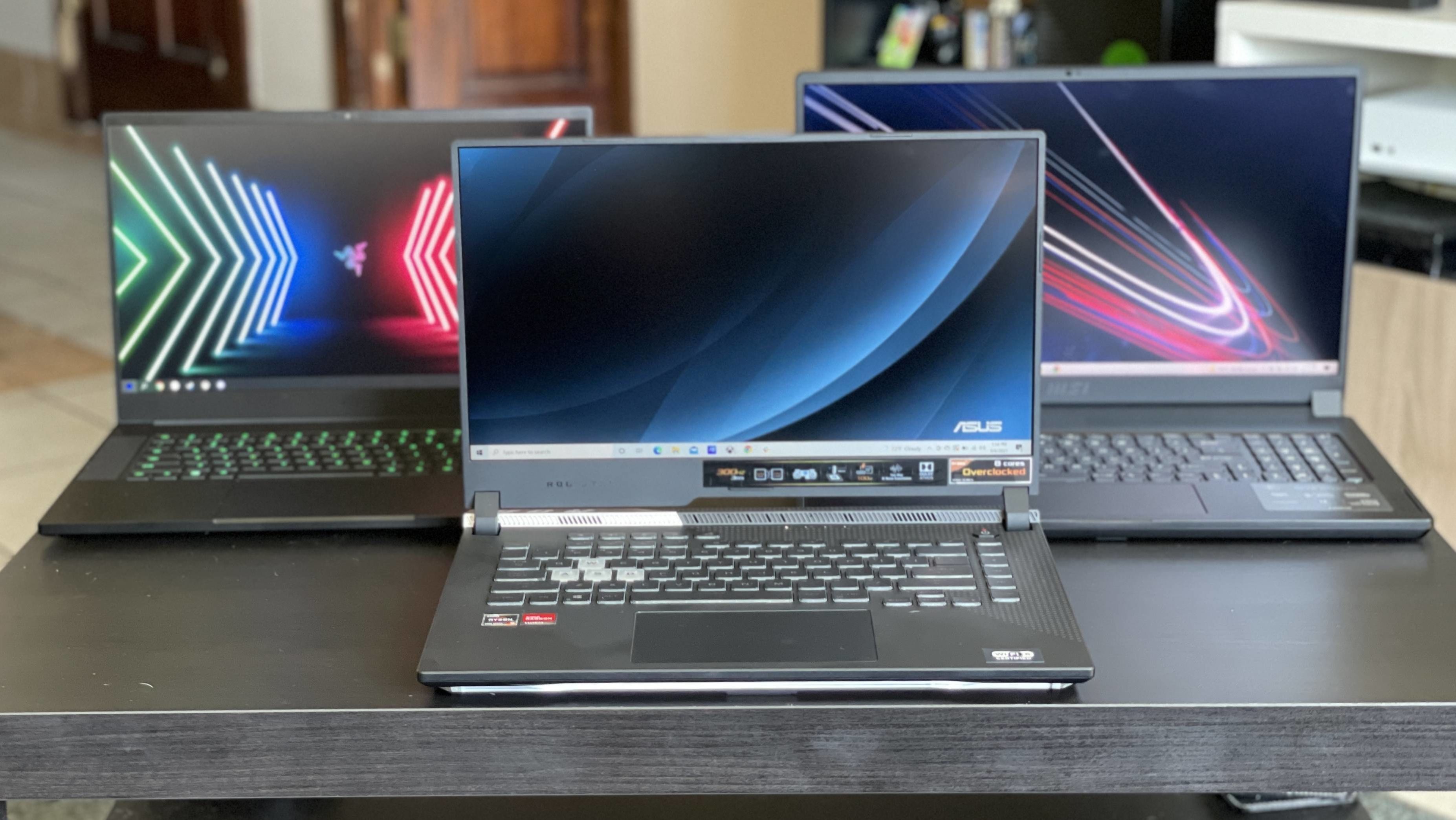Gaming laptops give you the power and flexibility to play the latest PC games anywhere while doubling as dependable work-from-home machines. They also come in a massive variety of styles and configurations, from compact and affordable notebooks with modest graphics cards to big-screen behemoths with flashy RGB lighting and desktop-grade power.
With so many options to choose from, we’ve done the hard work (including playing lots and lots of video games) to make finding the right notebook as easy as possible for you. After extensively testing nine of the top gaming laptops on the market, we’ve picked out three excellent standouts that are all worth your cash.
Best gaming laptop overall: Asus ROG Strix G15 Advantage Edition ($1,649; bestbuy.com)
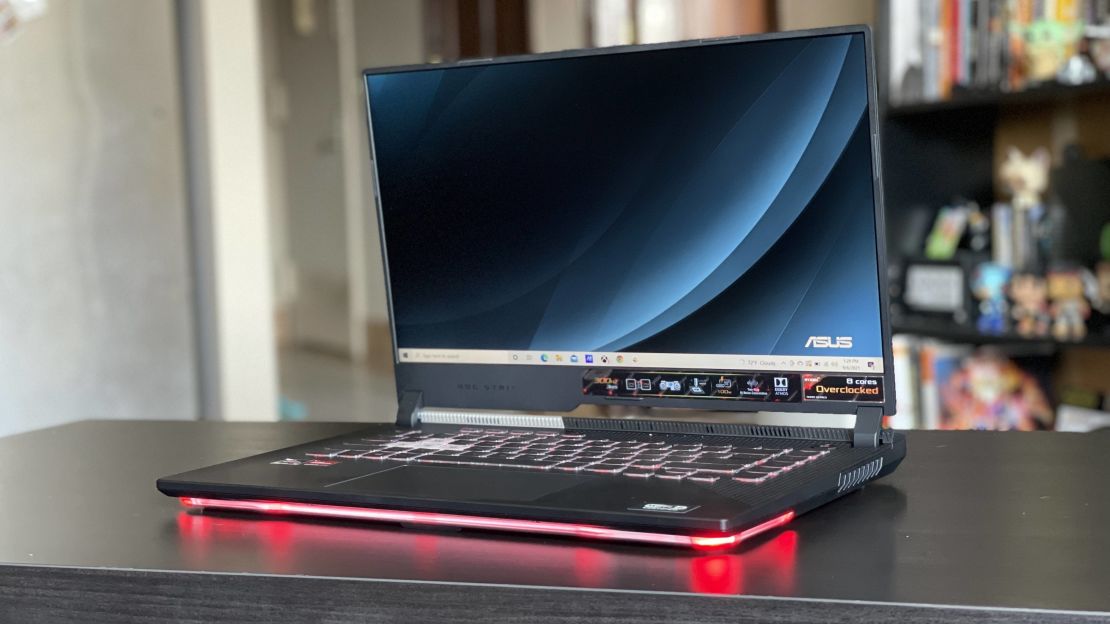
Key specs
- Display: 15.6-inch display at 1920 x 1080 and 300 Hz
- Processor: AMD Ryzen 9 5900HX
- Graphics: AMD Radeon RX 6800M
- RAM: 16GB
- Storage: 512GB
- Size and weight: 13.8 by 10.2 by 1.1 inches, 5.5 pounds
The Asus ROG Strix G15 Advantage Edition offers the best mix of performance, battery life and features for the price of any gaming laptop we tested — and it looks good too, with a look that’s clearly gamer-focused but won’t scare co-workers if you take it to the office This laptop regularly topped our benchmark tests while giving us no shortage of special features to play with, all for a very reasonable midrange price of $1,649.
The G15 Advantage Edition is unapologetically a gaming laptop, with just enough aesthetic flourishes to make it stand out from the pack without looking garish. Asus’ laptop is loaded with RGB lighting, which extends from the keyboard to an attractive light strip at the bottom of the PC that added a nice subtle underglow to our desk while we worked and played games. You also get three swappable faceplates for customizing the laptop’s hinge — our G15 was sporting a red plate out of the box, but we swapped in a silver one for a more sleek, subdued look. This type of physical customization isn’t very common on gaming laptops, and it’s nice to see.
While the G15’s keyboard isn’t quite as satisfying or snappy as the ones on the Lenovo Legion 5 Pro and Razer Blade 15 Advanced we tested, it was still very comfortable to type on for long stretches, with plenty of bounce and a nice soft-touch material coating each key. We especially appreciate the fact that the G15 has dedicated controls for media playback, volume control and even switching performance modes, all of which saved us from having to perform pesky keyboard shortcuts or searching for the system’s companion app.
The Strix G15 Advantage Edition’s 1080p display is plenty bright and colorful, making the cartoon-like action of Psychonauts 2 look especially rich and vibrant while preserving all of the cinematic detail of Marvel’s Avengers. The G15 looked a bit saturated and overly bright when performing everyday tasks like trawling Discord and cramming away in Google Docs, but that wasn’t as much of an issue while playing games.
It’s also worth noting that the Strix G15 has one of the highest refresh rates of any display we tested at 300 Hz. That means that everyday scrolling looked especially smooth, and that the laptop is capable of running games at especially high frame rates for the hypercompetitive Fortnite and Valorant players out there. And if you’d rather have a sharper display in favor of an extra-smooth one, Asus also offers a Strix G15 configuration with a quad HD (2560 x 1440) screen at 165 Hz.
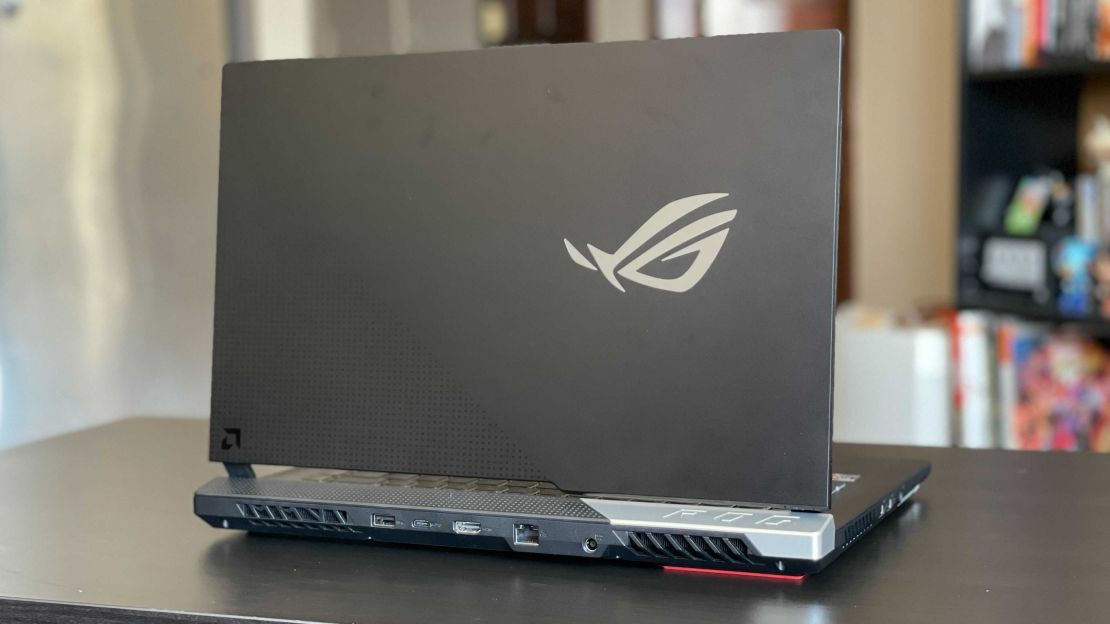
Where the Strix G15 Advantage Edition really shines is performance, delivering some of the most impressive benchmark results of our entire test pool while proving more than capable enough for our everyday gaming habits. Asus’ laptop rendered the photorealistic racing action of Dirt 5 better than any laptop we tested by a wide margin while trailing only the much more expensive Razer Blade 15 Advanced on our Rise of the Tomb Raider test. And when we sat down for extended sessions with Marvel’s Avengers, we enjoyed smooth frame rates as high as 80 frames per second (fps) while beating up bad guys with the graphics settings cranked to the max. You simply won’t have trouble running demanding games on this thing.
The Strix G15 Advantage Edition’s best-in-class performance also extends to its battery life, which outperformed our entire pool by lasting a very impressive eight hours on our continuous 4K playback test. That’s very high for a gaming laptop (the second-best result was Asus’ own Zephyrus G14 at just under six hours), and means that Asus’ notebook is well equipped for a workday’s worth of mixed use.
Asus’ Armoury Crate companion app is one of the more robust and intuitive we’ve used, allowing you to monitor your system’s overall usage, toggle different performance modes and, of course, play with the RGB lighting. There are no shortage of ways to make the G15 pulsate all kinds of different colors here, complete with an Aura Creator app that, after a brief learning curve, allowed us to create custom patterns by adjusting individual zones on the keyboard.
Despite its stellar performance and great features, Asus’ laptop does have one major Achilles’ heel — there’s no webcam. We’re not quite sure why, as the laptop’s display bezels aren’t exceptionally thin, and it costs roughly the same as similarly specced machines with built-in cameras. It’s worth noting that every gaming laptop webcam we tested is pretty poor, and anyone who wants to look crisp and professional on video calls or Twitch streams can get a good dedicated webcam for pretty cheap. Still, the lack of an integrated camera does hurt the G15’s versatility as a work-from-home machine out of the box.
But if you don’t mind bringing your own camera to the party (or can live without one), the Asus ROG Strix G15 Advantage Edition’s performance, battery life and overall design is about as good as it gets for the price.
Best big-screen gaming laptop: MSI GS76 Stealth ($2,199; bestbuy.com)
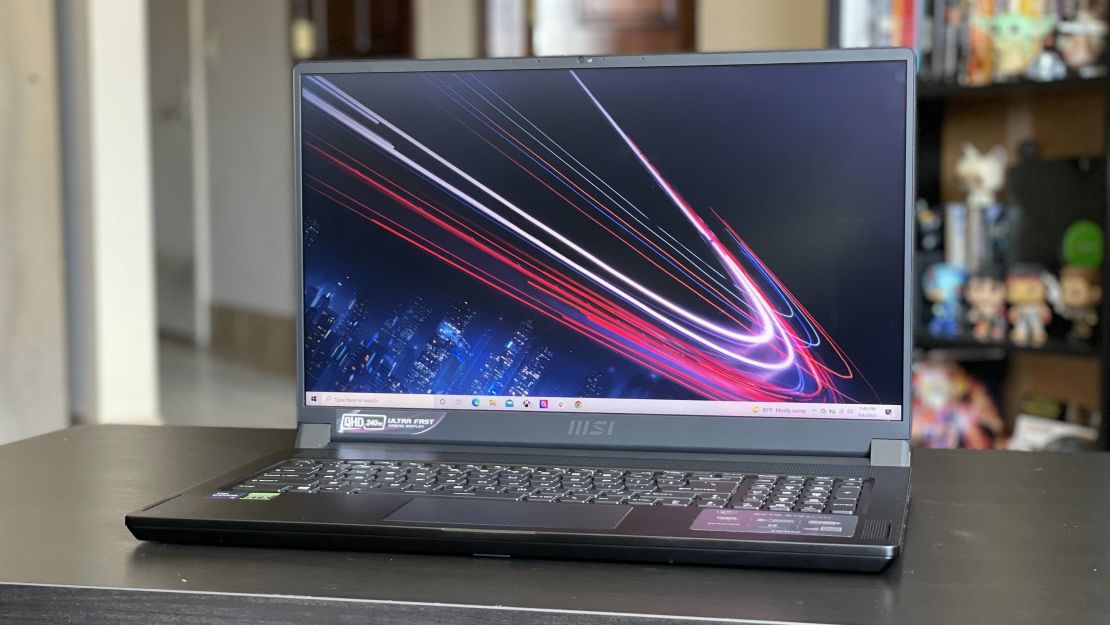
Key specs
- Display: 17.3-inch display at 2560 x 1440 and 240 Hz
- Processor: Intel Core i9-11900H
- Graphics: Nvidia GeForce RTX 3070
- RAM: 32GB
- Storage: 1TB
- Size and weight: 15.6 by 10.2 by 0.8 inches, 5.4 pounds
If your main priority is having a big, beautiful screen for getting lost in your favorite games, the MSI GS76 Stealth is for you. This laptop’s 17.3-inch display provides an excellent sweet spot between clarity and smoothness — and it’s backed by some of the best overall performance of any notebook we tested.
On top of being one of the biggest displays we’ve tested, the Stealth’s screen is also one of the brightest and most colorful. Everything from the black-and-white text of a Google Doc to the blues and oranges flooding the trailer for Marvel’s “Shang-Chi” looked thick and bold, making it easy to stay focused on work and get fully immersed in movies and games.
Part of why the MSI GS76’s display looks so great is that it offers a nice middle ground between resolution (how sharp things look) and refresh rate (how smoothly things move). The laptop’s 2560 x 1440 screen can pack in more detail than the 1080p displays we see on most gaming laptops, without the extra-high cost of a 4K display. Likewise, the screen’s 240 Hz refresh rate is higher than that of many mainstream gaming laptops, which makes everyday activities like scrolling through webpages more fluid while allowing games to run at a very high maximum frame rate. You typically have to compromise between a sharp resolution and a speedy refresh rate, but the GS76 Stealth comes as close as possible to giving you the best of both worlds. And if you’re a competitive gamer who would rather have the maximum refresh rate possible, there’s an identically priced option that swaps in a 1080p, 360 Hz screen.
On top of having a gorgeous, smooth display, the MSI GS76 delivered some of the best overall performance of any gaming laptop we got our hands on. MSI’s notebook is well equipped to handle a heavy daily workload, turning in the best Geekbench 5 processing scores of our entire testing pool while handling long hours of heavy Chrome surfing, Slacking and word processing without a stutter. The GS76 Stealth also consistently landed within the top three for gaming tests, pumping out very high frame rates for Shadow of the Tomb Raider and Dirt 5. During more casual gameplay, we enjoyed a rock-solid 60 fps (our baseline for smooth gaming) while running Marvel’s Avengers at the highest graphics settings at 1440p resolution. TL;DR: This machine can run pretty much any mainstream game with ease, and you won’t have to make many compromises in terms of fidelity.
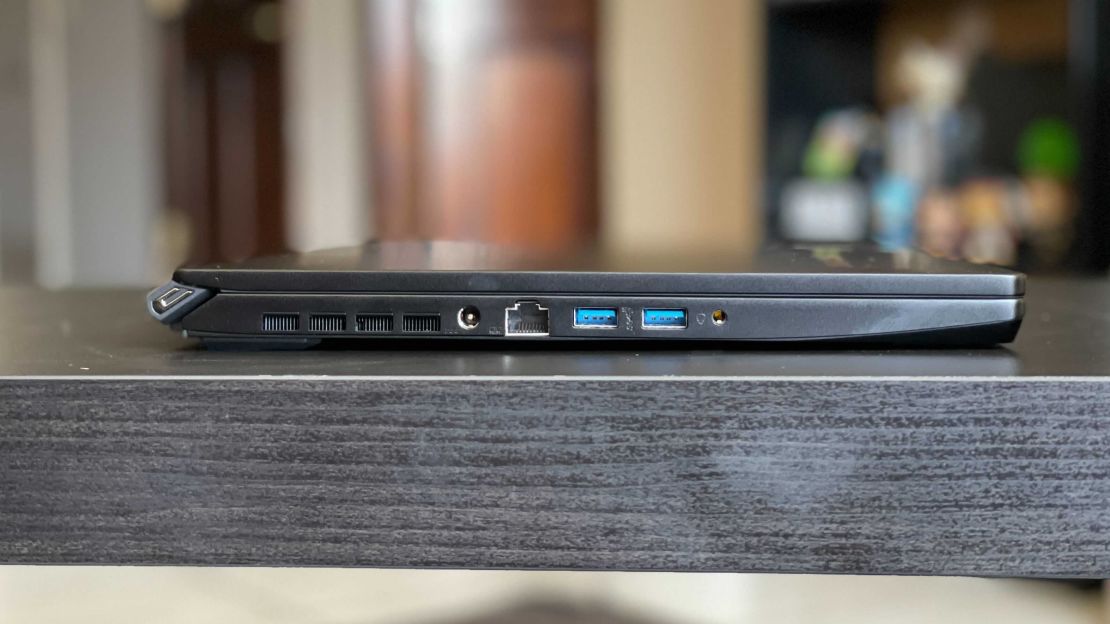
The Stealth’s performance is all the more impressive when you consider how relatively sleek it is for a 17-inch laptop. While its wide chassis seems more ideal for your desk than, say, an airplane seat, its 5.4-pound build doesn’t feel egregiously heavy (just make sure you have a big backpack if you plan on traveling with it). It’s one of the more subtle-looking gaming laptops we’ve used, with an attractive all-black look that’s second only to the Razer Blade 15 Advanced Edition in terms of unassuming style. The GS76 also has one of the best keyboards we’ve used on a gaming laptop, providing enough depth and springy feedback to keep us comfortable throughout the workday.
If you do manage to get the GS76 Stealth out of the house, you’ll be treated to some pretty solid battery life. MSI’s notebook lasted five hours and 30 minutes on our endurance test, which is on the higher end out of the models we tested and good for an afternoon’s worth of unplugged playtime.
MSI’s notebook has a fair amount of useful features, starting with an MSI Center app that lets you monitor your CPU and GPU usage and do things like disable the Windows key to avoid accidental dropouts while gaming. We especially appreciate the option to switch between balanced, silent, super battery and extreme performance profiles. The latter mode managed to get us slightly higher frame rates in Shadow of the Tomb Raider — just be warned that the machine can get loud should you choose to kick things into overdrive.
The Stealth also offers some pretty robust keyboard RGB customization via the SteelSeries GG app. While we found the software to have a bit of a learning curve compared to what the likes of Acer and Razer offer, we were eventually able to do everything from customize the color of individual keys to have the entire keyboard pulsate through complex, cool-looking patterns.
Our main nitpicks with the GS76 Stealth are pretty minor. Its webcam is pretty blurry (most of the ones we tested are), and it picks up fingerprints fairly easily. It’s also a significant investment at $2,199, but you’re getting a big, best-in-class display — and excellent performance — for the money.
Best splurge gaming laptop: Razer Blade 15 Advanced Model (starting at $2,699, $3,099 as tested; razer.com)
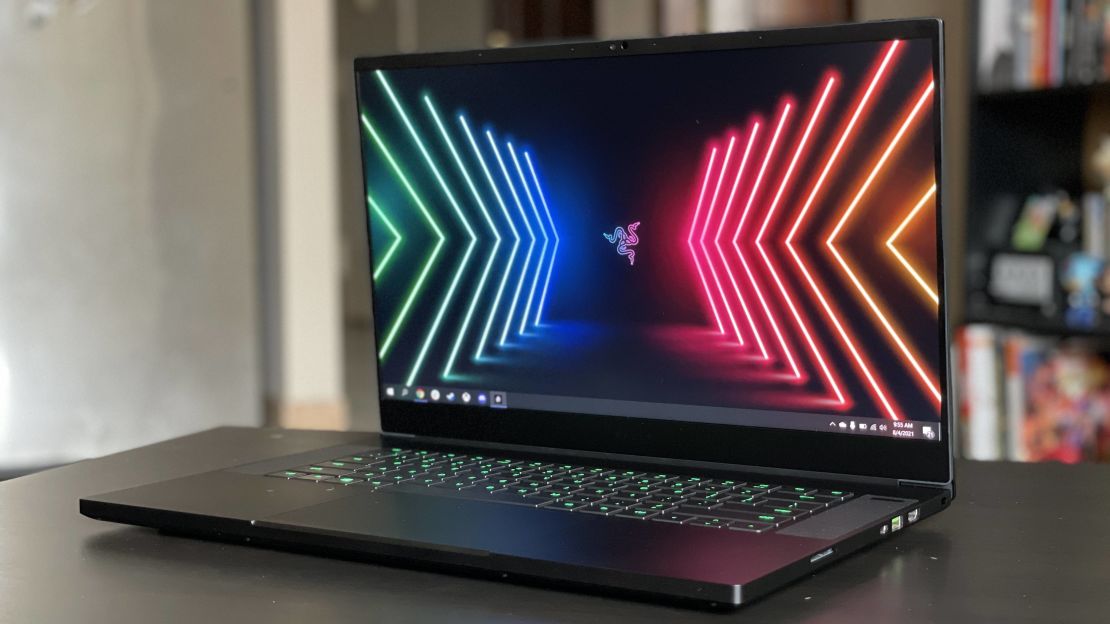
Key specs
- Display: 15.6-inch display at 1920 x 1080 at 360 Hz
- Processor: Intel Core i7-11800H
- Graphics: Nvidia GeForce RTX 3080
- RAM: 32GB
- Storage: 1TB
- Size and weight: 14 by 9.25 by 0.67 inches, 4.6 pounds
If you care about good looks as much as you care about cranking Call of Duty up to its maximum settings, the Razer Blade 15 Advanced Model is worth every bit of its premium price.
Razer’s high-end powerhouse is the most attractive notebook we tested. Its stylish black aluminum design is subdued enough to take to a coffee shop while still packing customizable RGB keyboard lighting for those who like to get flashy. It’s also the slimmest gaming laptop we’ve gotten our hands on, with edges that are about half an inch thin and a roughly 4.6-pound chassis that doesn’t feel too heavy.
But the Blade 15 Advanced has more than good looks going for it — it’s also one of the most powerful gaming laptops we’ve tested. Razer’s notebook ranked near the top of all of our performance tests, providing the smoothest overall frame rate of the pack in our Rise of the Tomb Raider benchmark while turning in some of the strongest results we’ve seen for both our Dirt 5 test and our raw processing power tests in Geekbench 5.
The Blade shined in everyday gameplay, allowing us to blow up killer robots in Marvel’s Avengers at upward of 100 fps with the graphics kicked up to high and a still very smooth 60 to 70 fps with visuals cranked to the max. That fluid performance was complemented by the Blade’s vibrant 15.6-inch display, which allowed purples, oranges and blues to pop off the screen as Hawkeye fired off colorful arrows in a dystopian wasteland.
The Blade 15 Advanced’s screen has the highest refresh rate of any laptop we tested at 360 Hz, which is to say that it’s ridiculously smooth. The benefits of this kind of screen were noticeable right away, as things like the movement of a mouse cursor or the scroll of a webpage had a pleasant fluidity to them that other laptops we tested couldn’t match. But high-refresh-rate screens are especially ideal for competitive gamers who want as much precision as possible when trying to snag headshots in their favorite shooter.
As such, we were pleased to find we were able to run Fortnite at upward of 200 to 300 fps with the graphics at modest settings (a number that can also partially be attributed to the laptop’s powerful Nvidia RTX 3080 graphics card). That’s a level of smoothness that might not matter to the average gamer but could prove crucial to hardcore players who want things to feel as responsive and accurate as possible.
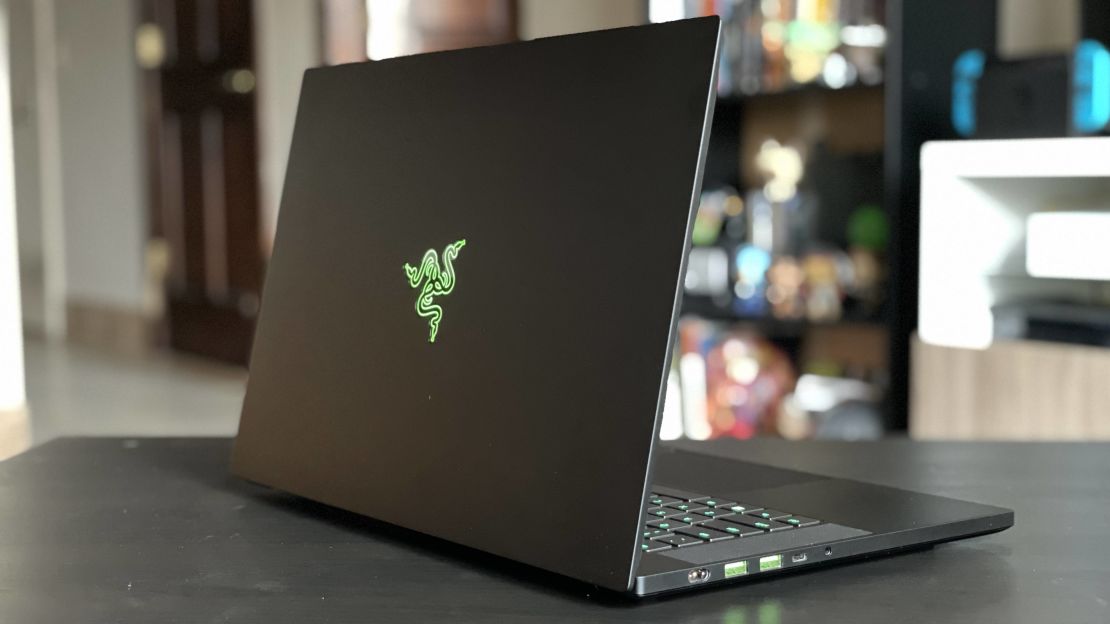
Razer’s laptop also has some of the best software and special features of any gaming notebook we tested. The included Synapse app makes it easy to customize the keyboard’s attractive RGB lighting, whether you want the keys to glow a single static color or cycle through the whole rainbow. We especially liked the option to make the function keys work as multimedia keys by default, which allowed us to do things such as change the volume or control media playback with a single tap instead of an annoying multi-button shortcut.
The Blade 15 Advanced does have some noteworthy drawbacks, starting with the battery life. Razer’s laptop had the shortest runtime of any laptop we tested, lasting for three hours with the display set to 60 Hz and a shorter two hours and 44 minutes with 360 Hz mode activated. This may not be a deal breaker if you plan to do most of your gaming at your desk while plugged in, but it does mean you’ll have to keep a charger handy while traveling. And while the Blade 15’s webcam is one of the better we’ve used on a gaming laptop, it still made us look pretty dull and washed out.
Sure, it’s expensive. But if it’s within your budget, the Blade 15 Advanced packs some of the best gaming laptop performance you can find into a gorgeous and slim design that you won’t be embarrassed to take out in public.
How to choose the right gaming laptop
Performance and specs: The most important specs to look for on any gaming laptop are the processor (CPU), which carries out general tasks, and its graphics card (GPU), which renders those advanced visuals that allow your games to run properly. Gaming laptops can come with a few different combinations of CPU and GPU — usually an Intel or AMD processor, and an AMD or Nvidia graphics card.
AMD components have grown pretty competitive with their Intel and Nvidia counterparts as of late, so choosing between the two largely comes down to some small performance differences. Many games are optimized for either Nvidia or AMD graphics cards to take advantage of special visual effects (such as ray tracing for ultrarealistic lighting and reflections), so you’ll want to check each manufacturer’s list of optimized titles before you take your pick.
A good entry-level system for solid 1080p gaming usually has some combination of an AMD Ryzen 5/Intel Core i5 processor and Nvidia RTX 3060 or AMD RX 5700 XT graphics, and can generally be found for $1,000 to $1,500. Midrange gaming laptops (for better 1080p performance or higher 1440p resolutions) tend to pack Nvidia RTX 3070 or AMD Radeon RX 6700M graphics, with prices hovering between $1,500 and $2,000. And if you want the best performance possible, look for an Intel Core i7/i9 or AMD Ryzen 9 processor and Nvidia RTX 3080 or AMD 6800M graphics — just be ready to pay upward of $2,000 to $3,000.
Resolution versus refresh rate: When it comes to the display, there are two important specs to look out for: resolution and refresh rate. Resolution represents how much detail a display can pump out, with most gaming laptops starting at 1080p and higher-end models going up to 2560 x 1440 and even 4K (3840 x 2160). The refresh rate tells you how rapidly a screen can refresh, with higher numbers allowing for a higher maximum frame rate and ultimately smoother gameplay. Refresh rates tend to start between 144 Hz and 165 Hz for gaming laptops, with some models going all the way up to 360 Hz.
High resolution usually comes at the expense of high refresh rate (and vice versa), so you’ll have to decide what type of viewing experience is most important to you. If you want your games to look as immersive and detailed as possible, opting for a 1440p or 4K display is the way to go. Gaming laptops with 4K screens are a bit rare and pretty expensive, but we find 1440p to be a nice middle ground that gets you rich visuals at a reasonable price. But if you’re a competitive gamer who values precision above all else, you’re better off with a 1080p display with a refresh rate in the 200s or higher.
Screen size and portability: Gaming laptops are generally bigger and bulkier than their non-gaming counterparts, but there’s still a decent range of size options and styles out there. Thirteen-inch gaming laptops are pretty rare, but there are a few 14-inch options for folks who want something as portable as possible. Most gaming laptops are in the 15-inch range, providing a nice middle ground of power, screen size and portability. Those who plan to do most of their gaming at home should consider 17-inch gaming laptops, which provide the biggest possible screen and generally powerful components but aren’t as convenient to lug around.
How we tested
We evaluated every gaming laptop in our testing pool using a mix of performance benchmarks and everyday real-world use. A gaming laptop is only as good as its gaming performance, so we ran the in-game benchmarks for Shadow of the Tomb Raider and Dirt 5 (both at 1080p with graphics settings turned all the way up) to gauge how smoothly each system could run modern blockbusters. The more frames per second, the better. We also spent lots of time simply playing games on these systems, dumping many hours into titles such as Marvel’s Avengers and Psychonauts 2 while taking note of things such as frame rate, visual fidelity, fan noise and the brightness and color of the display.
We also ran each laptop through Geekbench 5, a benchmark that evaluates a machine’s basic multitasking capabilities. Additionally, we used each of these notebooks as our main computer for at least a full workday, taking note of the quality of the keyboard, trackpad and speakers while typing up documents and hopping on video calls. For systems that included a webcam (some didn’t!), we took selfies via the Windows 10 Camera app and compared photo quality amongst the pool.
To measure battery life, we put each laptop through our in-house endurance test, which consists of playing a 4K video on a loop at 50% brightness with airplane mode turned on. We also factored in each system’s design — including portability, build quality and overall aesthetics — and the usefulness of extra features such as special performance modes and RGB lighting.
Others we tested
Lenovo Legion 5 Pro 16 ($1,529; walmart.com)
The Legion 5 Pro 16 came extremely close to making our top picks, offering a gorgeous quad HD display and a great keyboard within an attractive and well-built chassis. However, its gaming performance was mostly middle-of-the-road on our benchmarks, and its battery life, while good, trails the ROG Strix G15 by a significant margin.
Acer Predator Helios 300 ($1,430; amazon.com)
If you’re looking for a good value, there’s a lot to like about the Predator Helios 300. It’s got a premium-feeling design with attractive, angled edges and some nice RGB keyboard lighting options, as well as a fairly colorful and smooth 1080p display. Its gaming performance and battery life are middling to below average compared to other laptops we tested, but still dependable for the price.
Asus ROG Zephyrus G14 ($1,549; bestbuy.com)
The ROG Zephyrus G14 is the most compact gaming laptop we’ve tested, and one of the most attractive, thanks to its slick two-tone white-and-silver finish. We also really like the way the keyboard angles upward, which made long typing sessions feel comfortable. However, the Zephyrus G14’s performance results were on the average to lower end compared to the rest of the pool, and its display is on the saturated side. And like with other Asus ROG laptops, you’ll have to live without a webcam. The G14’s uniquely small design is worth considering for road warriors, but you can get better performance for the price.
Asus ROG Zephyrus G15 ($2,949; newegg.com)
The ROG Zephyrus G15 has most of the same pros and cons as the G14, just within a larger 15-inch design. It lasted significantly shorter than its smaller sibling on our battery test, and we found its speakers to be pretty quiet. You’ll get some really strong gaming performance out of this machine, but there are options with better displays (and an actual webcam) at this premium price.
Acer Nitro 5 ($1,699; amazon.com)
Despite being the more expensive of the two Acer laptops we tested, the Acer Nitro 5 feels the cheapest. Its plastic build has a lot of give to it, and its glossy exterior is highly susceptible to fingerprints. You’ll get some pretty good gaming performance out of this machine as well as a solid 1440p display, but you can also get sturdier, better-designed laptops for the price.
HP Omen 15 ($1,199; hp.com)
The HP Omen 15 is serviceable as an entry-level laptop but is still a bit behind the curve in its price range. Its display looks a bit dull compared to the competition, and its performance scores and battery life were on the lower end of our test pool. You’ll still get a sturdy, sleek design and a solid keyboard, but the Acer Predator Helios 300 is a better pick in this range.
Read more from CNN Underscored’s hands-on testing
